The Lenovo ThinkStation P900 Workstation Review: Design 101
by Ian Cutress on May 6, 2015 7:00 AM ESTProfessional Performance: Linux
Linux-Bench: link
Built around several freely available benchmarks for Linux, Linux-Bench is a project spearheaded by Patrick at ServeTheHome to streamline about a dozen of these tests in a single neat package run via a set of three commands using an Ubuntu 11.04 LiveCD. These tests include fluid dynamics used by NASA, ray-tracing, OpenSSL, molecular modeling, and a scalable data structure server for web deployments. We run Linux-Bench and have chosen to report a select few of the tests that rely on CPU and DRAM speed.
C-Ray: link
C-Ray is a simple ray-tracing program that focuses almost exclusively on processor performance rather than DRAM access. The test in Linux-Bench renders a heavy complex scene offering a large scalable scenario.
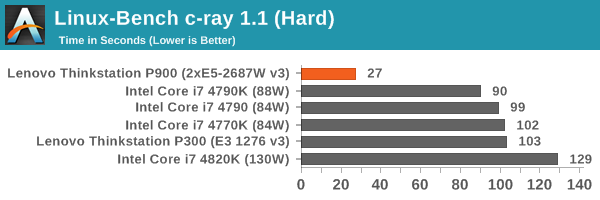
C-Ray doesn't have to deal with inter-CPU transfers or DRAM snooping, resulting in a good score.
NAMD, Scalable Molecular Dynamics: link
Developed by the Theoretical and Computational Biophysics Group at the University of Illinois at Urbana-Champaign, NAMD is a set of parallel molecular dynamics codes for extreme parallelization up to and beyond 200,000 cores. The reference paper detailing NAMD has over 4000 citations, and our testing runs a small simulation where the calculation steps per unit time is the output vector.
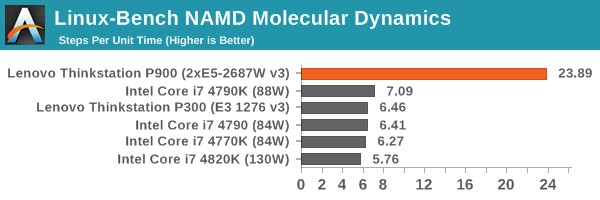
The NAMD libraries are designed to minimise any cross-CPU talking in order to extract performance out of an Intel system. As a result, we get a great result.
NPB, Fluid Dynamics: link
Aside from LINPACK, there are many other ways to benchmark supercomputers in terms of how effective they are for various types of mathematical processes. The NAS Parallel Benchmarks (NPB) are a set of small programs originally designed for NASA to test their supercomputers in terms of fluid dynamics simulations, useful for airflow reactions and design.
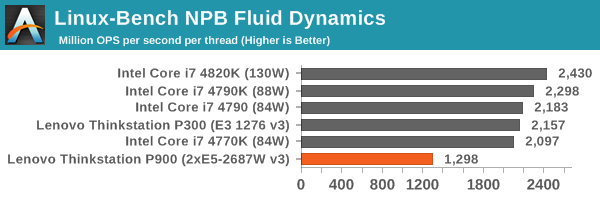
NPB gives a rather low score, based on millions of operations per second and per thread. As a result, a 40 thread system would easily outperform here, but the results are an indication of efficiency per thread.
Redis: link
Many of the online applications rely on key-value caches and data structure servers to operate. Redis is an open-source, scalable web technology with a b developer base, but also relies heavily on memory bandwidth as well as CPU performance.
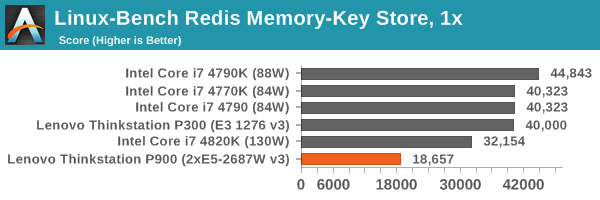
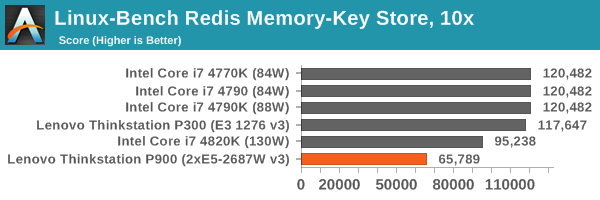

Redis prefers single socket systems almost exclusively, and as a result despite having DDR4-2133 in the P900, the cross-talking for the database takes a hit in the result.










61 Comments
View All Comments
ectoplasmosis - Wednesday, May 6, 2015 - link
Yes, the photos in most articles have been atrocious for a while now.It's not expensive or difficult to get a lightbox and learn how to use a DSLR...
xype - Wednesday, May 6, 2015 - link
I see a seasonic ad that goes right up to the to the article’s text edge. It makes it really, really hard to read. Great design, there.Samus - Wednesday, May 6, 2015 - link
Review system at $16,797.60That gave me a chuckle ;)
Flunk - Wednesday, May 6, 2015 - link
Workstation or loaded Hyundai Accent, which is better value?ImSteevin - Thursday, May 14, 2015 - link
Like with any tool, it depends what you need to do!DanNeely - Wednesday, May 6, 2015 - link
I'm a bit curious about part of the PSU design. From the label on the PSU itself, and the ODD/HDD power connectors on the mobo diagram, it's appears that during normal use the 3.3/5v power is being made using DC-DC converters on the mobo. (I suppose they could be dual purposing the +5Vsb unit in the PSU for part of that, but would've expected it to be marked differently if so.) I'm wondering why they left the -12v module in the PSU instead of moving it to the mobo (next to the RS232 port) as well. Are circuits that can invert DC power significantly more expensive/less efficient than something that could be done while closer to the AC?aggiechase37 - Thursday, May 7, 2015 - link
Does it come pre-loaded with spyware like their lappies? Also, whatever their excuse for the price: vom. I can build this system myself for a tenth of the price.zodiacfml - Friday, May 8, 2015 - link
Design 101? They should have taken a page from Apple's Mac Pro. As an engineer, I love that design despite an Apple hater. It doesn't have to be cylindrical externally or as compact but to be efficient in design.dragonsqrrl - Saturday, May 9, 2015 - link
This workstation seems woefully overpriced for the specs. A similarly spec'd Dell Precision costs ~$10,500.akula2 - Sunday, May 10, 2015 - link
The recent X99 based workstations I've built are far more superior in terms of low TDP. performance and savings. E.g.,E5-2680 v3: 12 Cores -- 120W -- 30Mb cache. -- costs much less.
Considering the investment for each workstation, the most important point missed:
How safe is the data in this machine when running Windows 7 or 8? Highly unlikely.
Hence, I chose Linux because of various reasons. E.g., PRNG issue, thanks to Intel's 'RdRand' CPU instruction.